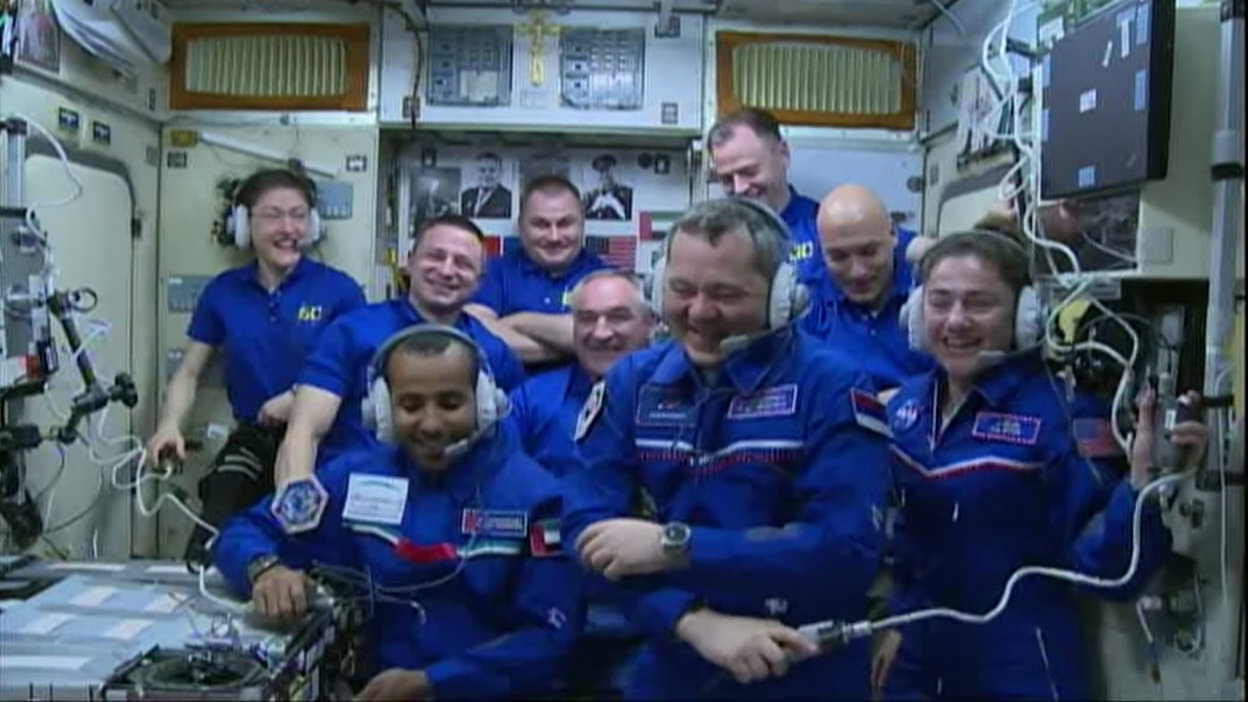Crowded Space Station: There Are 9 People from 4 Different Space Agencies in Orbit Right Now
It's a bit crowded at the International Space Station right now.
It's a busy week at the International Space Station (ISS). With nine crewmembers currently on board, the orbiting laboratory will be unusually crowded until Thursday (Oct. 3), when three of those crewmembers are scheduled to return to Earth.
While the ISS is usually staffed by three to six astronauts and cosmonauts, there have been nine crewmembers on board the space laboratory since last Wednesday (Sept. 25), when the Soyuz MS-15 spacecraft arrived with three new crewmembers. This isn't a permanent set-up; part of the reason there are so many humans in space right now has to do with overlap in crew assignments.
Nine is certainly not the highest number of people ever stationed on the space lab. The record for the largest population on the ISS was set in 2009, when there were 13 people on board. The last time there were nine people on board was in 2015, during NASA astronaut Scott Kelly's "Year in Space" mission.
Related: Expedition 60: The Space Station Mission in Photos

Over the course of the eight days when the space station will be a bit of a tight fit, the newly-arrived trio will get acclimated to their new orbiting home, while three other space flyers will prepare to head back down to Earth.
The new residents are NASA astronaut Jessica Meir and Roscosmos cosmonaut Oleg Skripochka, who will spend six months in space as members of Expedition 61, plus a special short-term visitor: the first person from the United Arab Emirates (UAE) to fly into space, Hazzaa Ali Almansoori. The three launched on board Russia's Soyuz MS-15 spacecraft last Wednesday (Sept. 25) from the Baikonur Cosmodrome in Kazakhstan shortly before 7 p.m. local time, and arrived at the space lab about six hours later.
Almansoori's brief visit is part of an intergovernmental contract between the UAE and Roscosmos, according to NASA. Almansoori will return to Earth this Thursday (Oct. 3) on the Soyuz MS-12 spacecraft, accompanied by NASA astronaut Nick Hague and ISS commander Alexey Ovchinin, both of whom will have completed more than 200 days in space.
Get the Space.com Newsletter
Breaking space news, the latest updates on rocket launches, skywatching events and more!

Also on board the ISS right now are the crew of the Soyuz MS-13 spacecraft: NASA astronaut Drew Morgan, European Space Agency astronaut Luca Parmitano and Russian cosmonaut Alexander Skvortsov. The three spacemen arrived at the ISS on July 20 and will return to Earth sometime in December or January. Three of the men (Parmitano, Ovchinin and Hague) are celebrating birthdays this week. To celebrate, all nine crewmembers donned "space band" shirts for a photo this week.
Ovchinin, who is currently the commander of Expedition 60, will hand over command of the ISS to Parmitano on Wednesday (Oct. 2), marking the official beginning of Expedition 61. You can watch the change of command ceremony live on Space.com beginning at 9:20 a.m. EDT (1320 GMT), courtesy of NASA TV. Later that night, we'll stream live views of the crew farewells (beginning at 12:20 a.m. EDT on Oct. 3), followed by the Soyuz MS-12 undocking and landing early Thursday morning.
Celebrando 3 compleanni in una settimana, con le maglie della nostra 'space band': 'Kryk Chayky' – 'Lo strillo del gabbiano'. Celebrating 3 birthdays in one week (Me + @AstroHague & Alexey), wearing the t-shirts of our 'space band': 'Kryk Chayky' – 'The cry of the seagull'. pic.twitter.com/HtcS9jdlcZSeptember 30, 2019
- International Space Station: By the Numbers
- What's it Like to Become a NASA Astronaut?
- This Astronaut Photo of Her Friend's Launch Into Space Is Absolutely Stunning!
Follow Doris Elin Urrutia on Twitter @salazar_elin. Follow us on Twitter @Spacedotcom and on Facebook.

Join our Space Forums to keep talking space on the latest missions, night sky and more! And if you have a news tip, correction or comment, let us know at: community@space.com.

Doris is a science journalist and Space.com contributor. She received a B.A. in Sociology and Communications at Fordham University in New York City. Her first work was published in collaboration with London Mining Network, where her love of science writing was born. Her passion for astronomy started as a kid when she helped her sister build a model solar system in the Bronx. She got her first shot at astronomy writing as a Space.com editorial intern and continues to write about all things cosmic for the website. Doris has also written about microscopic plant life for Scientific American’s website and about whale calls for their print magazine. She has also written about ancient humans for Inverse, with stories ranging from how to recreate Pompeii’s cuisine to how to map the Polynesian expansion through genomics. She currently shares her home with two rabbits. Follow her on twitter at @salazar_elin.









